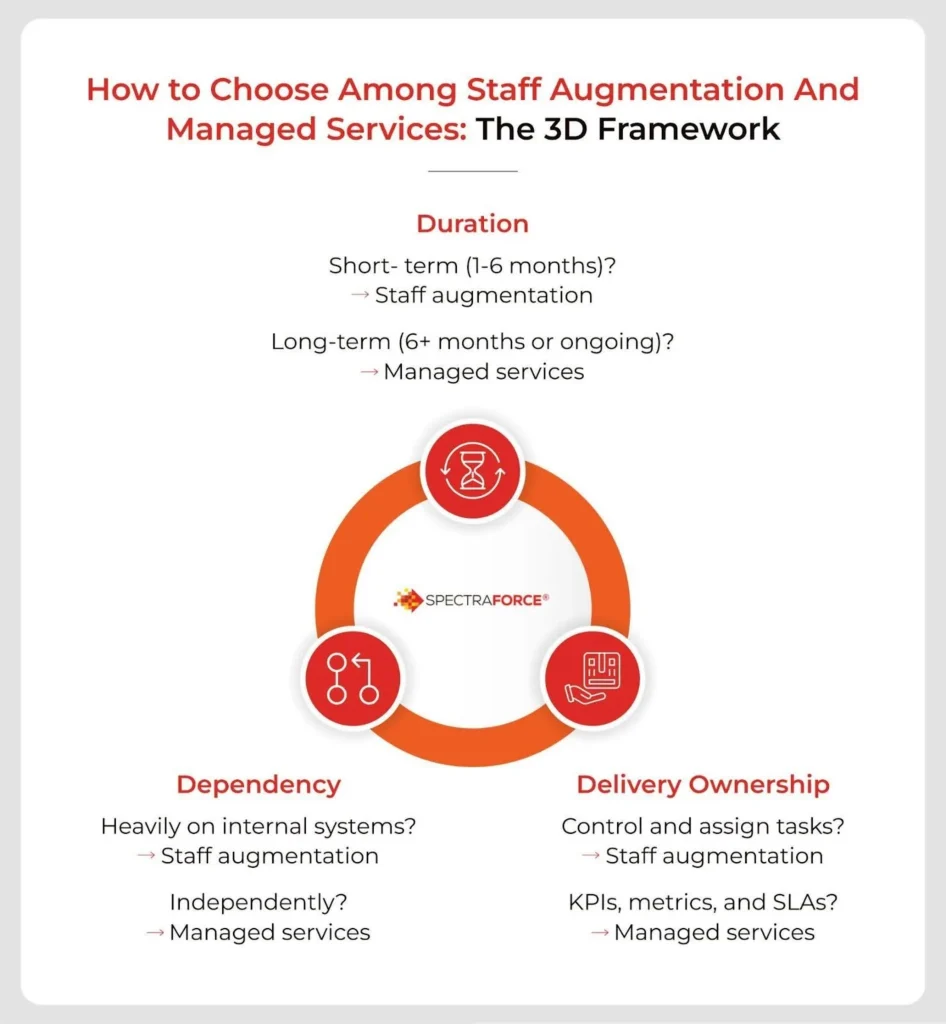When your business is scaling fast, talent becomes a bottleneck. Maybe you’re launching a new product, entering a new market, or racing to fulfill post-funding goals. Whatever the reason, you need more hands, and fast.
That’s when two common staffing models enter the conversation: staff augmentation and managed services. Both bring in external expertise. But how they work and when they work are very different stories.
Staff augmentation extends your team with external talent you manage. Managed services hand off entire functions to a partner who owns delivery. Choosing between the two isn’t just about cost—it’s about control, accountability, and risk. And getting it wrong can slow progress when speed matters most.
So, how do you pick the right model? Let’s break it down.
What Is Staff Augmentation?
Staff augmentation is a flexible outsourcing strategy that allows businesses to hire external talent to supplement their existing in-house team. These professionals typically work under your internal management structure, using your tools, systems, and processes.
Let’s understand with this example: A mid-size fintech company hires two UI/UX designers through an IT staff augmentation firm to accelerate a 6-week sprint without committing to full-time hires.
Think of it as renting talent while still maintaining control over the outcomes.
What Are Managed Services?
Managed services involve outsourcing an entire function or project to a third-party provider. The provider assumes full responsibility for delivery, quality, and performance, often defined under a service-level agreement (SLA).
Here’s an example: An enterprise outsources its entire infrastructure monitoring and incident response to a managed services provider that operates 24×7.
In this model, you’re outsourcing ownership. The provider is accountable for the results, not just the tasks, making it fundamentally different from simply extending your team. And this is why choosing the right managed service provider is crucial, because you’re trusting them not just to execute, but to deliver business outcomes at scale. The right partner supports your goals and helps you reach them faster, with fewer risks along the way.
Staff Augmentation vs Managed Services: Key Differences
Here’s how the two stack up across key parameters:
| Feature | Staff Augmentation | Managed Services |
| Control | You maintain control over tasks and priorities | Provider controls execution and performance |
| Cost Predictability | More variable (hourly/daily/monthly rates) | More predictable (fixed scope or retainer) |
| Onboarding Time | Fast – plug into your system | Slower – setup phase required |
| Scalability | High – scale up/down easily | Moderate – tied to contract terms |
| Accountability | Shared – you manage delivery | Provider owns delivery outcomes |
| Best For | Short-term projects, skill gaps | Long-term functions, full ownership needs |
Each model has trade-offs. The real challenge? Knowing when those trade-offs align with your goals.
Pros and Cons of Staff Augmentation and Managed Services
Staff Augmentation: Pros
- Flexibility:
Hire exactly who you need, when you need them. Whether it’s a cloud architect for six weeks or a QA tester for two sprints, staff augmentation allows you to plug in talent without reshuffling your org chart. - Speed:
Augmented staff can often be onboarded in days, not weeks, especially when working with experienced vendors. That makes it ideal for urgent launches or unplanned scale-ups. - Lower Commitment:
No long-term contracts, payroll obligations, or benefits to worry about. You scale resources up or down based on need, without carrying the cost burden once the project ends.
Staff Augmentation: Cons
- Management Overhead:
You’re still responsible for managing day-to-day work, deadlines, and performance. If your internal bandwidth is already stretched, this can add pressure instead of relieving it. - Inconsistent Quality:
Not all augmented talent delivers the same value. Quality varies depending on the individual or vendor, and unless you’re vigilant, gaps in skill or cultural fit can derail progress. - Scattered Responsibility:
With augmented staff, the work may be external but the responsibility still lies with you. If something goes wrong, the accountability for fixing it doesn’t automatically shift to the provider.
Managed Services: Pros
- Outcome Ownership:
You’re outsourcing deliverables. The provider takes end-to-end ownership of the outcome, including KPIs, uptime, and SLAs, freeing your team to focus on core priorities. - Predictable Cost:
Managed services are usually scoped and priced upfront. That means no surprise bills, even when the provider adjusts resourcing behind the scenes to meet commitments. - Expertise at Scale:
Providers bring in mature systems, processes, and tools. Apart from getting people, you’re getting access to a refined operating model built for scale.
Managed Services: Cons
- Less Control:
You don’t get to assign individual tasks or tweak timelines mid-sprint. You’re managing the contract, not the contributors, so flexibility can take a hit. - Longer Setup:
Defining scope, setting SLAs, and aligning on tools takes time. Managed services aren’t ideal for addressing immediate needs or objectives that are not well-defined. - Risk of Misalignment:
If business goals aren’t clearly communicated or if they evolve mid-project the provider may deliver exactly what was scoped, even if it no longer meets your needs.
How to Choose Among Staff Augmentation And Managed Services: The 3D Framework

When evaluating staff augmentation vs managed services, consider the 3Ds:
1. Duration
- Short-term (1–6 months)? Staff augmentation likely fits better.
- Long-term (6+ months or ongoing)? Managed services deliver more value through ownership and continuity.
2. Dependency
- Does the function depend heavily on internal systems, tools, or workflows?
Staff augmentation works better. - Does it operate independently (e.g., help desk, cloud monitoring)?
Managed services make sense.
3. Delivery Ownership
- Do you want to retain control and assign daily tasks?
Choose staff augmentation. - Want a partner to handle KPIs, metrics, and SLAs?
Go managed.
If you’re still unclear, consider piloting a hybrid model.
Use Cases: Which Model Works Best for Whom?
Benefits of staff augmentation are most pronounced for:
- Startups in a growth sprint needing niche skills quickly.
- In-house teams that want to stay lean but agile.
- Companies with robust project management in place.
Managed Services Fit Best When:
- You want to outsource a non-core function completely.
- You’re scaling enterprise IT or support operations.
- SLAs, uptime, and performance metrics are critical.
Hybrid Approaches Work When:
- You want core delivery managed but internal oversight on a few key roles.
- For example: A managed DevOps pipeline with two augmented QA specialists reporting to your product manager.
Can You Combine Staff Augmentation and Managed Services?
Yes, and often, you should.
Many companies use a hybrid outsourcing model where managed services handle high-volume, repeatable tasks, while staff augmentation is used to fill gaps in high-impact or niche areas.
Think of it as: Managed services for consistency, staff augmentation for agility.
This allows you to scale smartly, stay cost-efficient, and maintain the right level of control.
Conclusion: What the Future Holds
The truth is, neither model is going away. In fact, the lines are already blurring.
With increasing demand for flexibility, companies are exploring modular outsourcing, combining both models into agile, SLA-driven talent ecosystems. AI and automation are further accelerating this shift, especially in IT, engineering, and customer service domains.
If you’re still evaluating staff augmentation vs managed services, don’t treat it as a binary decision. Use the 3Ds, duration, dependency, and delivery Ownership to assess what you need now and what you’ll need 6 months from now. Your decision shouldn’t just fit your budget; it should scale with your business.
FAQs
To decide whether your project needs short-term talent or long-term management, use the duration lens: short-term gaps (under 6 months) are best filled via staff augmentation. Long-term support or transformation projects benefit more from managed services.
The biggest risk if you choose staff augmentation for complex projects is diffused responsibility. If outcomes matter more than task execution, relying solely on augmented staff may leave gaps in ownership and coordination.
To evaluate cost-effectiveness between staff augmentation and managed services, look at the total cost of ownership, not just hourly rates. Staff augmentation may seem cheaper, but management overhead and delivery delays can add up. Managed services typically offer better predictability and bundled value.
Managed services take control of outcomes; you monitor performance via SLAs. Staff augmentation gives you more tactical control but keeps outcome responsibility on your shoulders.
Yes, hybrid models will combine the benefits of both approaches better. Hybrid models are gaining traction, particularly in dynamic industries where agility and accountability must coexist. Expect to see more hybrid SLAs and blended teams in the coming years.



